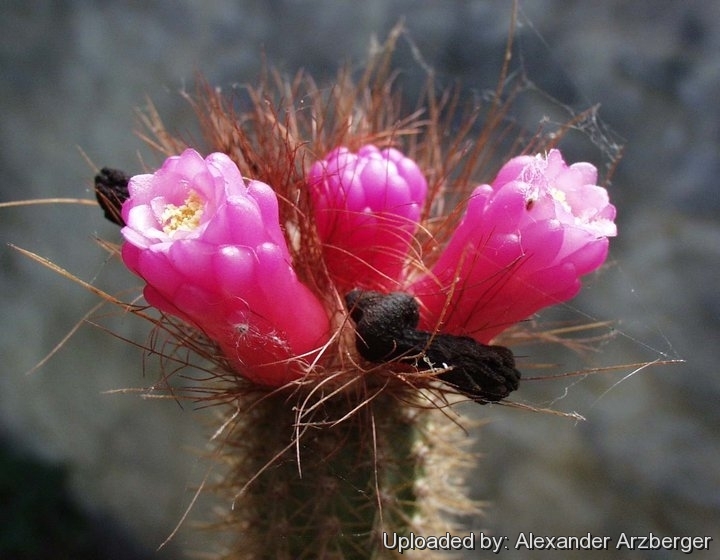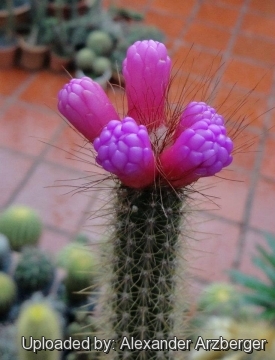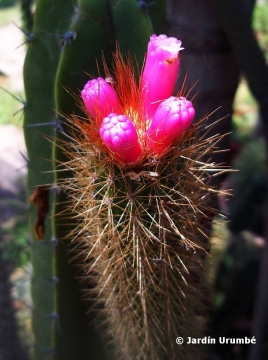
Arrojadoa rhodantha subs. aureispina Photo by: Alexander Arzberger
Origin and Habitat: Brumado, Bahia, Brazil
Altitude range: 200 metres above sea level.
Habitat and ecology: This species grows together with Melocactus zehntneriSN|20575]]SN|20575]] and terrestrial bromeliads.
Synonyms:
See all synonyms of Arrojadoa rhodantha
Description: Arrojadoa aureispinaSN|4847]]SN|4839]] is a clustered, cylinder-shaped cactus with golden-yellow spines that produces apical clusters of pinkish purple flowers. It was discovered by Albert F. H. Buining and described in1972, It is generally included within (as a synonym of) Arrojadoa rhodanthaSN|4847]]SN|4847]], suggesting that there is not really a fundamental difference between the two, and hard to name accurately without knowing where they come from, and there remains a considerable confusion surrounding the true identity of this this plant.
Derivation of specific name: the specific name “aureispina”, yellow spined, refers to characteristic golden-yellow spines of this plant.
Stems: Cylindrical, erect or semi-erect, up to one metre long and about 5 cm in diameter, typically with axillary branches that appear to arise from the cephalia from almost near the base.
Ribs: 14.
Areoles: Woolly golden yellow.
Radial spines: About 12 thin, needle-like ca. 8 mm long.
Central spines: 8-9 more long and robust (up to 14 mm), straight, pale yellow to dark golden yellow and shiny.
Cephalia Composed of dense, long brown hairs.
Flowers: Tubular, in clusters at the tip of stems from the cephalium, liliac-pink to deep carmine red, about 3 cm long and only one cm in diameter.
Chromosome number: 2n = 22
For more details see: Arrojadoa rhodanthaSN|4839]]SN|4847]]
Subspecies, varieties, forms and cultivars of plants belonging to the Arrojadoa rhodantha group
Bibliography: Major references and further lectures
1) Juliana P. Castro, Luiz G.R. Souza, Lânia F. Alves, Ana E.B. Silva, Marcelo Guerra & Leonardo P. Felix. 1073 Marhold (ed.) “IAPT/IOPB chromosome data 15” TAXON 62 (5) • October 2013: 1073–1083
2) “Arrojadoa - Travail de collationnement: Alain Beullens” <http://tenoch.free.fr/pagesweb/Docs/pdf/Arrojadoa.pdf>
3) Root Groelick, Marlon Machado “Aaxillary branching of lateral cephalia of Coleocephalocereus (Cactaceae)” Haseltonia 17: 35–41. 2012
4) “Arrojadoa aureispina 1936” Texte & Photo : Joël Lodé, Collection : Cactus Park, Tenerife, Canaries. © Edisud, Aix, 1998 Série 21 <https://www.cactuspro.com/biblio_fichiers/pdf/Lode/LodeC-Acanthocalycium-Ferocactus_O.pdf>
 Arrojadoa rhodantha subs. aureispina Photo by: Alexander Arzberger
Arrojadoa rhodantha subs. aureispina Photo by: Alexander Arzberger Arrojadoa rhodantha subs. aureispina Photo by: Alexander Arzberger
Arrojadoa rhodantha subs. aureispina Photo by: Alexander Arzberger Arrojadoa rhodantha subs. aureispina Photo by: Alexander Arzberger
Arrojadoa rhodantha subs. aureispina Photo by: Alexander ArzbergerSend a photo of this plant.The gallery now contains thousands of pictures, however it is possible to do even more. We are, of course, seeking photos of species not yet shown in the gallery but not only that, we are also looking for better pictures than those already present.
Read More... Cultivation and Propagation: These tropical cacti are not the easiest things to grow and aren’t plants for beginners. With their snake-like growth they are ideal cactus for hanging baskets.
Growth rate: It is a relatively rapidly growing given the best conditions.
Soils: It requires a rich but very porous mineral cactus mix soil.
Repotting: The root system is weak and generally resents being repotted and can take a long time to re-establish. Use pot with good drainage.
Light: They prefer very bright light, not as much as the most arid growing cacti, but plenty nonetheless. Tends to bronze in strong light, which encourages flowering and heavy spine production.
Watering: They grow from April to October and cannot endure long stretches of total dryness, and also too much water will rot them, as their weak root systems tends to be inefficient at sucking up water from wet soil. Nonetheless, again as a result of their tropical origins, they need a fair amount of water, but allow the soil to dry quite a bit before watering again.
Fertilization: Do not feed in winter.
Hardiness: They rest from October to April but can’t stand cold, or even fairly cool temperatures, so is indispensable to keep them above 8-12°C at all times, severe damage or death occurring at temperatures that the great majority of cacti wouldn’t mind in the least and prefer more frequent water in winter than other cacti, say once a month. (but hardy to 4 C ° C for short periods). However warmth throughout the year will increase the grower's success (minimum 12° to 20° C during rest season).
Pests & diseases: It may be attractive to a variety of insects, but plants in good condition should be nearly pest-free, particularly if they are grown in a mineral potting-mix, with good exposure and ventilation. Nonetheless, there are several pests to watch for:
- Red spiders: Red spiders may be effectively rubbed up by misting the vulnerable plants every day
- Mealy bugs: Mealy bugs occasionally they develop aerial into the new growth among the wool with disfiguring results, but the worst types develop underground on the roots and are invisible except by their effects.
- Scales: Scales are rarely a problem.
- Rot: it is only a minor problem with cacti if the plants are watered and “aired” correctly. If they are not, fungicides won't help all that much.
Propagation: Exclusively by Seeds. Sow in February-march in a light, sandy, porous soil. Cover germinating tray with glass to prevent seed from drying out. Germination is most successful at a temperature of 18 to 22° C. It can also be propagated by lateral offshoots (if available), grafting is not necessary.













